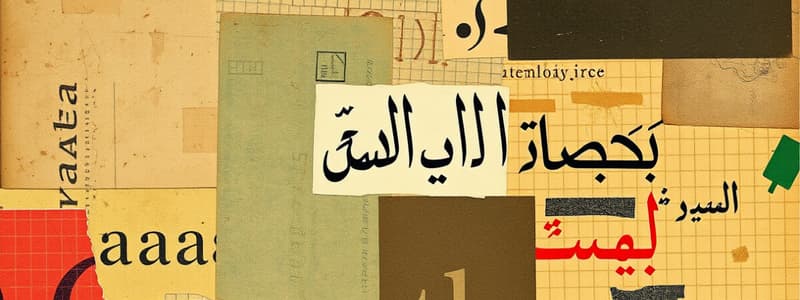Podcast
Questions and Answers
How many letters are there in the Arabic alphabet?
How many letters are there in the Arabic alphabet?
- 32
- 28 (correct)
- 30
- 26
Which of the following letters represents a sound not found in English?
Which of the following letters represents a sound not found in English?
- ت (tā')
- ق (qaf) (correct)
- ب (bā')
- د (dāl)
What direction is Arabic written in?
What direction is Arabic written in?
- Right to Left (correct)
- Bottom to Top
- Left to Right
- Top to Bottom
Which of the following is a correct pronunciation technique in Arabic?
Which of the following is a correct pronunciation technique in Arabic?
What is the Arabic equivalent of 'Goodbye'?
What is the Arabic equivalent of 'Goodbye'?
Which vowel marking represents the /a/ sound in Arabic?
Which vowel marking represents the /a/ sound in Arabic?
What is one of the main features of Arabic cursive script?
What is one of the main features of Arabic cursive script?
What length of vowels is represented by Alif, Waw, and Ya in Arabic?
What length of vowels is represented by Alif, Waw, and Ya in Arabic?
ما هي الفتحة؟
ما هي الفتحة؟
ما هي الضمة؟
ما هي الضمة؟
ما هي الكسرة؟
ما هي الكسرة؟
ما هو السكون؟
ما هو السكون؟
Flashcards are hidden until you start studying
Study Notes
Arabic Alphabet Study Notes
Letters and Sounds
- Total Letters: 28 consonants in the Arabic alphabet.
- Additional Letters: Some dialects include additional letters (e.g., گ, پ, چ).
- Distinct Sounds:
- Arabic has sounds not found in English, such as ق (qaf), ع (ayn), and غ (ghayn).
- Emphasis on pharyngeal sounds (e.g., ح and ع).
Writing Rules
- Right to Left: Arabic is written from right to left.
- Cursive Script: Most letters connect to each other, changing shape based on their position (initial, medial, final, or isolated).
- Letter Forms:
- There are 4 forms for most letters depending on their position in a word.
- Example: ب (bā') has forms: ب (initial), ـبـ (medial), ـب (final), and ب (isolated).
Pronunciation Techniques
- Phonetic Nuances:
- Focus on articulated sounds; practice with native speakers to master pronunciation.
- Use of voiced and voiceless consonants is crucial (e.g., ب [b] vs. ت [t]).
- Tajweed: Rules for proper pronunciation, especially when reciting the Quran.
Common Words
- Greetings:
- مرحبا (Marhaban) - Hello
- السلام عليكم (As-salamu alaykum) - Peace be upon you
- Basic Vocabulary:
- نعم (Na'am) - Yes
- لا (La) - No
- شكرا (Shukran) - Thank you
- مع السلامة (Ma'a as-salama) - Goodbye
Vowel Markings
- Short Vowels:
- Fatḥa ( ـَ ) - represents /a/ sound.
- Damma ( ـُ ) - represents /u/ sound.
- Kasra ( ـِ ) - represents /i/ sound.
- Long Vowels:
- Alif (ا) for /aa/, Waw (و) for /uu/, and Ya (ي) for /ii/.
- Diacritics: Used to indicate short vowels and other pronunciation guides; often omitted in casual writing.
Letters and Sounds
- 28 consonants comprise the Arabic alphabet.
- Certain dialects feature additional letters, such as گ (gāf), پ (pā), and چ (chā).
- Unique sounds include ق (qaf), ع (ayn), and غ (ghayn), which are not found in English.
- Arab phonetics emphasize pharyngeal sounds, particularly ح (ḥā) and ع (ayn).
Writing Rules
- Arabic script is read and written from right to left.
- The cursive nature of Arabic means letters connect and adjust their forms based on their position in a word: initial, medial, final, or isolated.
- Most letters have four forms; for example, ب (bā') changes to ب (initial), ـبـ (medial), ـب (final), and ب (isolated).
Pronunciation Techniques
- Articulation of sounds is crucial; practicing with native speakers enhances pronunciation.
- Differentiation between voiced (ب [b]) and voiceless (ت [t]) consonants is essential.
- Tajweed guidelines govern the proper pronunciation of words, particularly during Quranic recitations.
Common Words
- Basic greetings include مرحبا (Marhaban - Hello) and السلام عليكم (As-salamu alaykum - Peace be upon you).
- Essential vocabulary includes نعم (Na'am - Yes), لا (La - No), شكرا (Shukran - Thank you), and مع السلامة (Ma'a as-salama - Goodbye).
Vowel Markings
- Short vowels are represented as follows:
- Fatḥa ( ـَ ) for the /a/ sound
- Damma ( ـُ ) for the /u/ sound
- Kasra ( ـِ ) for the /i/ sound
- Long vowels include Alif (ا) for /aa/, Waw (و) for /uu/, and Ya (ي) for /ii/.
- Diacritics indicate short vowels and pronunciation tips, often omitted in informal writing.
Short Vowels and Sukun
- Fathah (فتحة): Involves opening the lips while pronouncing a letter, creating an 'a' sound.
- Dhammah (ضمة): Requires rounding the lips during pronunciation, producing a 'u' sound.
- Kassrah (كسرة): Involves lowering the lips while pronouncing a letter, resulting in an 'i' sound.
- Sukun (سكون): Indicates the absence of any vowel movement at the point of articulation, leading to a steady pronunciation without additional sound.
Studying That Suits You
Use AI to generate personalized quizzes and flashcards to suit your learning preferences.




